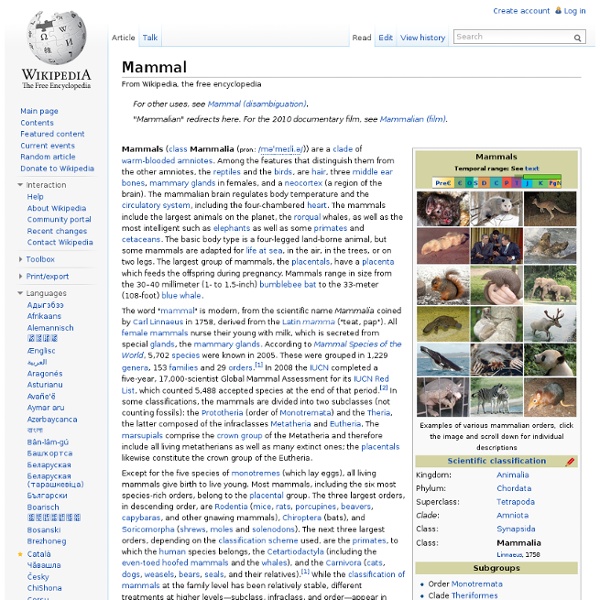



Ornithopod Ornithopods /ɔrˈnɪθɵpɒd/ or members of the clade Ornithopoda /ɔrnɨˈθɒpədə/ are a group of ornithischian dinosaurs that started out as small, bipedal running grazers, and grew in size and numbers until they became one of the most successful groups of herbivores in the Cretaceous world, and dominated the North American landscape. Their major evolutionary advantage was the progressive development of a chewing apparatus that became the most sophisticated ever developed by a non-avian dinosaur, rivaling that of modern mammals like the domestic cow. They reached their apex in the duck-bills, before they were wiped out by the Cretaceous–Paleogene extinction event along with all other non-avian dinosaurs. Members are known from all seven continents, though they are generally rare in the Southern Hemisphere. Description[edit] The early ornithopods were only about 1 metre (3 feet) long, but probably very fast. Sizes of the largest ornithopods Classification[edit] Taxonomy[edit] Phylogeny[edit]
Ferae According to recent studies (reflected in the diagram below), the closest relatives of Ferae are Perissodactyla (horses, tapirs and rhinos) and Cetartiodactyla (which combines Artiodactyla--camels, pigs, ruminants and hippos—with Cetacea--whales and dolphins).[2][3] An alternate phylogeny (less supported) holds that the closest relatives to Ferae are Perissodactyla and Chiroptera (bats), not Cetartiodactyla.[4] Ferae together with Perissodactyla has been called Zooamata. Ferae, Perissodactyla, and Chiroptera together has been called Pegasoferae.
Crocodylomorpha Crocodylomorpha is an important group of archosaurs that includes the crocodilians and their extinct relatives. During Mesozoic and early Cenozoic times, Crocodylomorpha was far more diverse than it is now. Triassic forms were small, lightly built, active terrestrial animals. These were supplanted during the early Jurassic by various aquatic and marine forms. The Later Jurassic, Cretaceous, and Cenozoic saw a wide diversity of terrestrial and semi-aquatic lineages. "Modern" crocodilians do not appear until the Late Cretaceous. Evolutionary history[edit] When their extinct species and stem group are examined, the crocodylian lineage (clade Crurotarsi) proves to have been a very diverse and adaptive group of reptiles. During the Jurassic and the Cretaceous, marine forms in the family Metriorhynchidae, such as Metriorhynchus, evolved forelimbs that were paddle-like and had a tail similar to modern fish. Phylogenetic definition[edit] Taxonomy and phylogeny[edit] Phylogeny[edit] References[edit]
Paenungulata Of the five orders, hyraxes are the most basal, followed by embrithopods; the remaining orders (sirenians, desmostylians and elephants) are more closely interrelated. These latter three are grouped as the Tethytheria, because it is believed that their common ancestors lived on the shores of the prehistoric Tethys Sea; however, recent myoglobin studies indicate that even Hyracoidea had an aquatic ancestor.[2] Although morphological evidence continues to support the position of paenungulates with the ungulates, the molecular evidence suggests that Paenungulata is part of the cohort Afrotheria, an ancient assemblage of mainly African mammals of great diversity. The other members of this cohort are the orders Afrosoricida (tenrecs and golden moles), Macroscelidea (elephant shrews) and Tubulidentata (aardvarks).[1] History[edit] Later, genetic techniques were developed for inspecting amino acid differences among haemoglobin sequences. Gallery[edit] See also[edit] Sources[edit] References[edit]
Ceratopsia Triceratops are by far the best-known ceratopsians to the general public. It is traditional for ceratopsian genus names to end in "-ceratops", although this is not always the case. One of the first named genera was Ceratops itself, which lent its name to the group, although it is considered a nomen dubium today as its fossil remains have no distinguishing characteristics that are not also found in other ceratopsians.[2] Anatomy[edit] Centrosaurus, with large nasal horn, exaggerated epoccipitals, and bony processes over the front of the frill. Museum of Victoria. Ceratopsians are easily recognized by features of the skull. History of study[edit] The first ceratopsian remains known to science were discovered by Fielding Bradford Meek during the U.S. Classification[edit] Taxonomy[edit] Triceratops, one of the largest ceratopsians (a chasmosaurinae ceratopsid). Following Marsh, Ceratopsia has usually been classified as a suborder within the order Ornithischia. Phylogeny[edit]
Arachnid Almost all extant arachnids are terrestrial. However, some inhabit freshwater environments and, with the exception of the pelagic zone, marine environments as well. They comprise over 100,000 named species, including spiders, scorpions, harvestmen, ticks, mites and Solifugae.[3] Anatomy[edit] Like all arthropods, arachnids have an exoskeleton, and they also have an internal structure of cartilage-like tissue called the endosternite, to which certain muscle groups are attached. Locomotion[edit] Physiology[edit] Further adaptations to terrestrial life are appendages modified for more efficient locomotion on land, internal fertilisation, special sensory organs, and water conservation enhanced by efficient excretory structures as well as a waxy layer covering the cuticle. The excretory glands of arachnids include up to four pairs of coxal glands along the side of the prosoma, and one or two pairs of Malpighian tubules, emptying into the gut. Diet and digestive system[edit] Senses[edit]
Pachycephalosauria Pachycephalosauria (/ˌpækɨˌsɛfəlɵˈsɔriə/; from Greek παχυκέφαλοσαυρος for 'thick headed lizards') is a clade of ornithischian dinosaurs. Well-known genera include Pachycephalosaurus, Stegoceras, Stygimoloch, and Dracorex. Most lived during the Late Cretaceous Period, in what is now North America and Asia. They were all bipedal, herbivorous/omnivorous animals with thick skulls. In some fossils, the skull roof is domed and several inches thick; in others it is flat or wedge-shaped. While the flat-headed pachycephalosaurs are traditionally regarded as distinct species or even families, they may actually represent juveniles of dome-headed adults.[1][2] The domes were often surrounded by nodes and/or spikes. Paleobiology[edit] Head-butting behavior[edit] Restoration of head butting Pachycephalosaurus The adaptive significance of the skull dome has been heavily debated. Also, the rounded shape of the skull would lessen the contacted surface area during head-butting, resulting in glancing blows.
Dromopoda